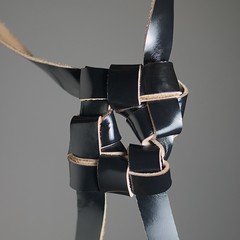The knots used to tie the straps of tefilin1 are halacha leMoshe miSinai and must be tied lishma by a Torah-observant adult Jewish male.
The knot of the shel rosh should be constructed to evoke the Hebrew letter “ד”. There are two prevalent ways to tie the knot:
- The knot itself has the shape of a small letter ד.
- The knot is square and the straps that come out of it create the shape of a ד.
The square knot – which is called “the simple knot” in the sources – is probably the more ancient design, although a case could be made that the ד knot is preferable. In any event, the exact structure of the knot may not be important, as long as the knot evokes a “ד” in some way.
The Double-ד
 There is a third, rarely seen, type of knot which is made from two ד knots – an inverted ד under a regular ד. This is most likely the true “double-ד” knot2. This double-ד knot is mentioned by some sources as having kabalistic origins, but many authorities discourage its use.
There is a third, rarely seen, type of knot which is made from two ד knots – an inverted ד under a regular ד. This is most likely the true “double-ד” knot2. This double-ד knot is mentioned by some sources as having kabalistic origins, but many authorities discourage its use.
In recent times, some have misunderstood the various statements by poskim opposing the double-ד to be critical of the square knot. Unfortunately, this misinterpretation has led some people to switch their knot from the square to the ד. In their attempt to be more “authentic”, these people have abandoned the knot which is clearly described by the Rishonim, and is most likely the original knot design.
The Ideal Knot
Since there is some disagreement among the sources as to the preferred knot, and since both the ד knot and the square knot fulfill the halachic requirements according to most poskim, each person should follow his family tradition and use the knot that his own father and grandfather used3. In a situation where someone does not have a clear tradition to use one knot or the other, he should follow the custom of his community. If there is no clear communal custom (as is often the case in the modern era), he should use the square knot.
-= 8 =-
-
for a brief overview of tefilin straps, see STAM 101: Retzu’os. ↩
-
in contrast to the square knot, the double-ד knot has a hole in the middle – making it look somewhat like a ם. ↩
-
For someone whose family tradition is to wear the kabalistic double-ד knot, there may be halachic grounds for switching to one of the more common knots. In these circumstances it would be best to consult with a competent halachic authority. ↩


